Offshore wind farm developments - public perceptions: survey
Findings from a survey exploring public perceptions of offshore wind farm (OWF) developments in Scotland. It describes whether and how respondents in Scotland have been impacted by OWFs, their attitudes to OWFs, and how OWFS affect their tourism and recreation choices.
This document is part of a collection
3 Perceptions of offshore wind farms
This chapter will discuss issues directly related to offshore wind and related developments. As a reminder, the definitions used to discuss respondents are in Table 3.1.
| Term | Definition |
|---|---|
| All respondents | Respondents from both the national and the coastal surveys. |
| National respondents | Respondents who took part in the nationally representative survey, defined as those who live in postcodes in Scotland with or without a coastal border. |
| Coastal Respondents | Respondents who took part in the targeted coastal survey, defined as those who live in postcodes with a coastal border. |
| Lived experience | Respondents who have the same outward postcode as an area which is used during the construction of an offshore wind farm. This includes areas where there is onshore infrastructure, where the offshore cables make landfall and areas which are parallel to the offshore development. |
3.1 Awareness of offshore wind farm developments
Almost a quarter (24%) of national respondents said that they are aware of an offshore wind farm near to where they live; this compares with more than two in five (43%) coastal respondents who said that they were aware of an offshore wind farm near to them (Figure 3.1).
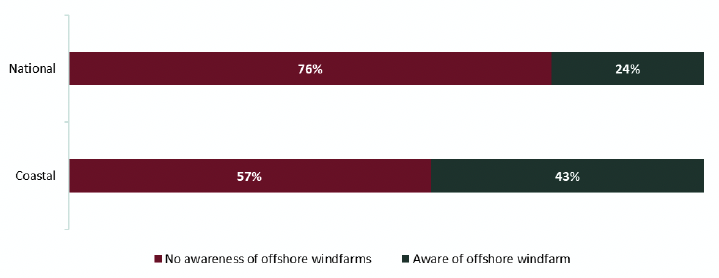
Base: Scottish Residents (National n= 1,000, Coastal n= 1,065)
Before analysing the results further, it is important to note that all respondents were asked about their 'awareness' of offshore wind farms located 'near to where you live'. This means the interpretation of 'near to where you live' by respondents is subjective; respondents may have different ideas about what constitutes 'near', and a respondent who may not consider themselves to be 'near' to the wind farm but are fully aware of a development could answer 'yes', whereas another respondent in the same situation could answer 'no'. This should be borne in mind when considering the data.
Respondents were then asked about the development with which they were most familiar, and around half of respondents who are aware of an offshore wind farm near to where they live named the Aberdeen Bay offshore wind farm (47%). A number of factors may explain this. Firstly, it could be due to that development's proximity to the coast, as Aberdeen Bay offshore wind farm is only 3 kilometres from the shore. Secondly, it may be due to the population density of the area, and this is explored in further detail within a specific case study in a later section below. Thirdly, the Aberdeen Bay offshore wind farm received significant media attention which may have resulted in greater levels of knowledge. There was also some awareness of Beatrice (12%), Kincardine (11%) and Moray (10%) as set out in Figure 3.2.

Base: Those aware of offshore wind farms (combined National and Coastal respondents) (689)
Aberdeen Bay Offshore Wind Farm: A Case Study
A total of 322 respondents with an AB postcode prefix (237 coastal respondents and 85 national respondents) took part in the study, representing 16% of the entire sample. To put that into context, respondents from Inverness, Dundee or Kirkwall represent 7%, 10% and 3% of the entire sample respectively.
The AB postcode area is large (Figure 3.3), with 40 postcode districts and over 17,000 live postcodes and has a relatively high population density. As the sample was not stratified, to ensure even coverage along the coast, it follows that there will be a large number of respondents from the Aberdeen area, and awareness of the Aberdeen Bay offshore windfarm may be higher as a result.
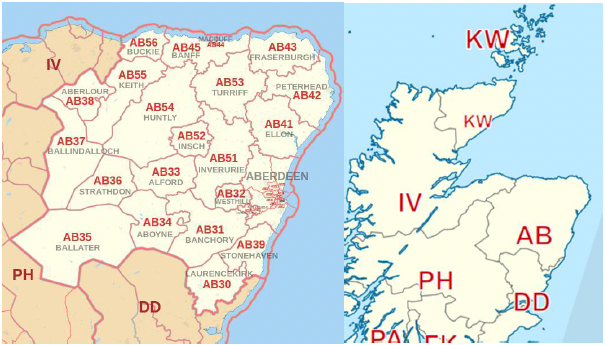
Awareness of the Aberdeen Bay offshore wind farm is not limited to those within the AB postcode area, however. Of those respondents having awareness of the Aberdeen Bay offshore wind farm, two-thirds (66%) of respondents have an Aberdeen (AB) postcode, while the rest are from Dundee (DD), Kirkwall (KW) or Inverness (IV) postcode areas (Figure 3.4).
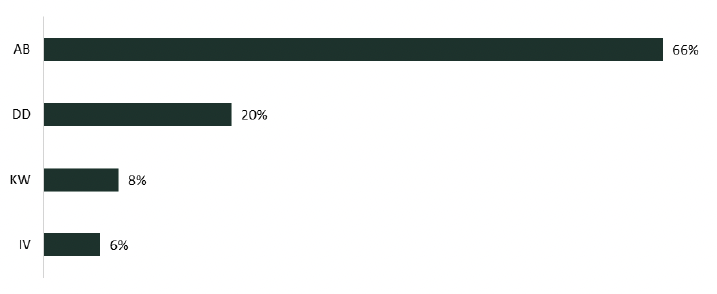
Base: National (n = 85), Coastal (n = 237)
This suggests that the high level of awareness of the Aberdeen Bay offshore wind farm is not restricted to the Aberdeen area and is not purely a result of the sampling used for the survey. Other factors such as the media attention given to the development and its proximity to shore may also play a part.
3.2 Approval of offshore wind farms
Among both national and coastal respondents there is extensive support for offshore wind farms, with around four in five people from both samples responding that they approve or strongly approve of them (Figure 3.5).
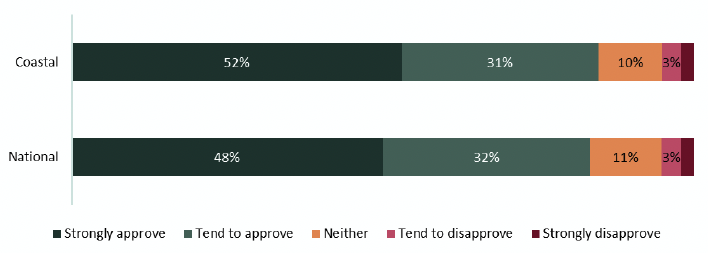
Base: Scottish Residents (Coastal n = 1,065, National n = 1,000)
Sub-group analysis of national respondents for this question revealed only two significant differences, namely that:
- men are more likely than women to approve of offshore wind farms, 85% versus 76%,
- those in the ABC1 social grades are more likely to approve of offshore wind farms than those in the C2DE grades, 83% versus 76%.
Among coastal respondents, younger people tend to be more likely to approve (61% of under 34-year-olds strongly approve compared to 40% of over 65-year-olds). On the same theme, coastal respondents most likely to disapprove of offshore wind farm developments were those aged 65+ (12% compared to 2% of those under 35 years old).
3.3 Awareness and approval
Approval towards offshore wind farms is highest among respondents who have awareness of an offshore wind farm (84% strongly approve or tend to approve). Even so, approval is still high among those with no awareness of an offshore wind farm near to where they live, with 78% of this cohort approving of offshore wind farms (Figure 3.6).
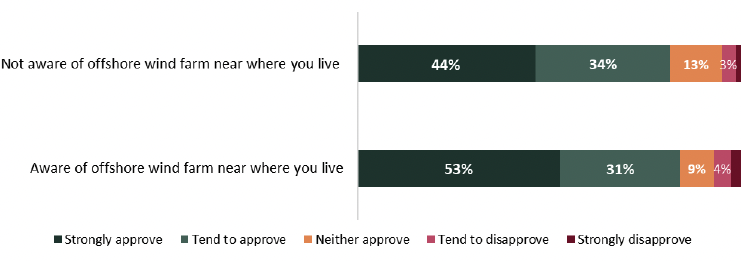
Base: Scottish Residents (Coastal n = 1,065, National n = 1,000)
Contact
Email: ScotMER@gov.scot
There is a problem
Thanks for your feedback